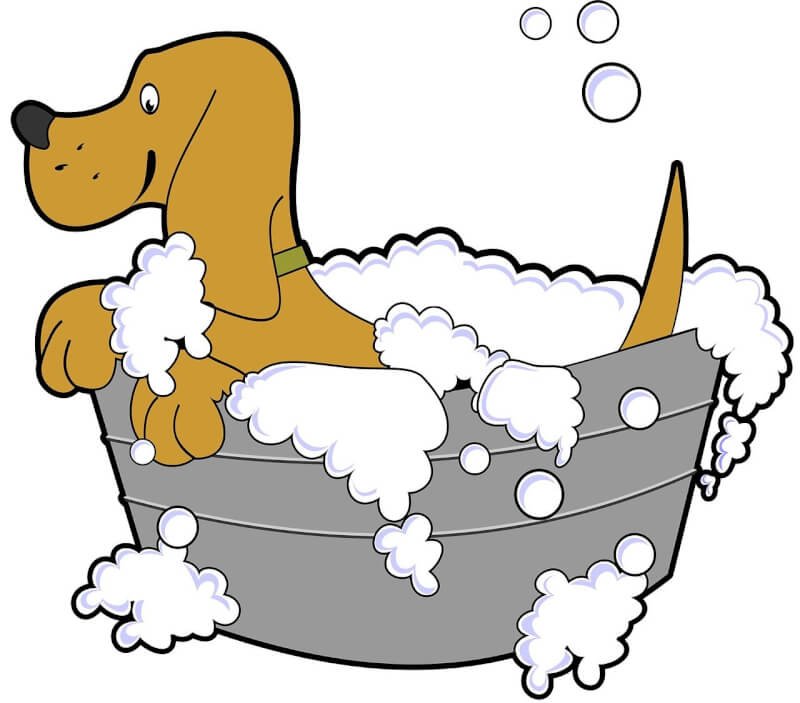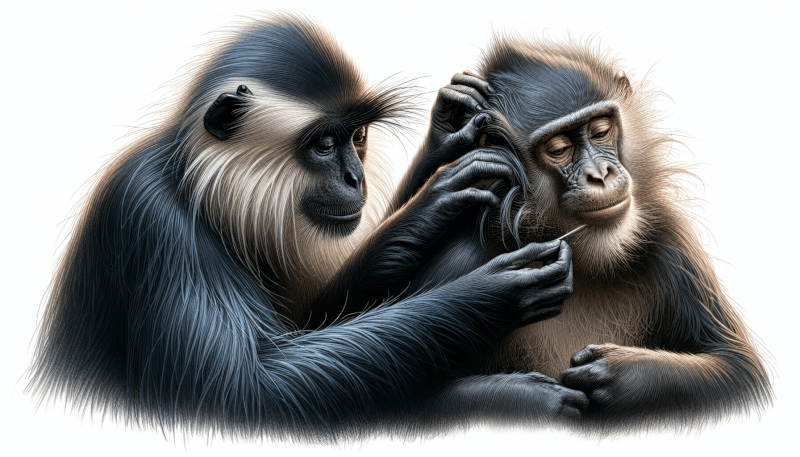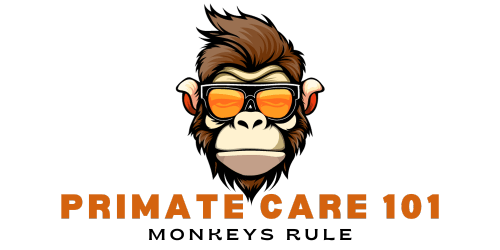In the fascinating world of primates, grooming plays a pivotal role in fostering strong social bonds. From apes swinging through the trees to monkeys thriving in the jungle, the act of grooming not only ensures personal hygiene but also acts as a powerful tool for building connections within primate communities. In this article, we will explore the significance of grooming in primate social bonding and unravel the intricate ways in which this seemingly simple gesture shapes their relationships and dynamics. So, grab your metaphorical comb and join us on this journey into the enthralling world of grooming among primates.

Overview of Primate Social Bonding
Definition of social bonding
Social bonding in primates refers to the long-term relationships and connections formed between individuals within a group. It involves various behaviors and interactions that contribute to the cohesiveness and stability of the social structure. This bonding is crucial for the overall well-being and survival of primates, as it facilitates cooperation, reduces conflict, and provides social support.
Importance of social bonding in primate groups
Social bonding plays a fundamental role in primate groups, providing numerous benefits for individuals and the group as a whole. It promotes trust, cooperation, and altruism among group members, strengthening overall group cohesion and cooperation in activities such as hunting, territory defense, and raising offspring. Socially bonded primates also experience reduced stress levels and enhanced overall health and survival rates.
Factors influencing social bonding
Several factors influence the development of social bonds among primates. These include proximity and opportunity for interaction, shared experiences, mutual interests, and communication through various forms such as grooming, vocalizations, and body language. Additionally, factors such as kinship, familiarity, and reciprocal behaviors contribute to the strength and durability of social bonds.
Introduction to Grooming as a Social Behavior
Definition of grooming
Grooming, in the context of social behavior, refers to the physical act of one individual cleaning or caring for the body of another. It involves behaviors such as picking through fur or hair, removing parasites, and providing comfort through gentle touch. Grooming is a prevalent social behavior observed in various primate species and serves multiple functions beyond just hygiene maintenance.
Types of grooming behaviors
Grooming behaviors can be categorized into two main types: allo-grooming and self-grooming. Allo-grooming involves one individual grooming another, while self-grooming refers to self-directed grooming behaviors. Allo-grooming is a more dominant form of grooming and plays a crucial role in building and maintaining social bonds between individuals within primate groups.
Frequency and duration of grooming
The frequency and duration of grooming vary among primate species and even within individuals and groups. Some species, such as bonobos and chimpanzees, engage in grooming sessions that can last for hours each day. Grooming frequency is influenced by factors such as group size, dominance hierarchies, social dynamics, and availability of resources. In some cases, grooming can be a group activity, with multiple individuals taking turns grooming each other.

Evolutionary Significance of Grooming
Grooming as a grooming tool
Grooming acts as a grooming tool, helping primates maintain their physical well-being. It aids in the removal of parasites, dead skin, and debris from the body, which can prevent infections and improve overall health. Additionally, grooming promotes the distribution of natural oils, maintaining the health and appearance of the primate’s fur or hair.
Benefits of grooming in primate societies
Beyond its physical benefits, grooming serves crucial social functions in primate societies. It strengthens social bonds, promotes social cohesion, and reinforces social hierarchies. By engaging in grooming, individuals establish and maintain trust, cooperation, and affiliative relationships, leading to a more stable and functional social structure.
Role of grooming in kin selection
Grooming also plays a role in kin selection, a theory suggesting that individuals are more likely to groom close relatives as a way to increase their inclusive fitness. By engaging in grooming with kin, individuals indirectly promote the survival and reproduction of their own genes. Kin-directed grooming reinforces bonds and cooperation within family groups, ensuring the benefits of grooming extend to related individuals.
Effects of Grooming on Social Bonding
Formation of social bonds through grooming
Grooming acts as a powerful mechanism for the formation and maintenance of social bonds among primates. Through grooming, individuals establish trust, communication, and emotional connections. It creates a sense of intimacy and reciprocity, leading to the development of long-lasting social relationships.
Importance of grooming for group cohesion
Grooming significantly contributes to group cohesion and social stability within primate groups. By engaging in reciprocal grooming, individuals reinforce social bonds among group members, reduce conflict, and foster cooperation in various group activities. Grooming helps in resolving conflicts, diffusing tension, and promoting overall harmony within the social structure.
Role of grooming in establishing dominance hierarchies
Grooming plays a crucial role in establishing and maintaining dominance hierarchies within primate groups. Dominant individuals often receive more grooming from subordinates, who engage in grooming as a form of deference and submission. This grooming behavior reinforces the social status and authority of dominant individuals while ensuring social order and stability within the group.

Neurophysiological Basis of Grooming
Effects of grooming on neurotransmitters
Grooming has been found to have neurophysiological effects on the primate brain. It stimulates the release of neurotransmitters such as dopamine and endorphins, which are associated with feelings of pleasure and reward. These neurochemical reactions contribute to the positive feelings associated with grooming and reinforce the motivation to engage in grooming behavior.
Role of oxytocin in grooming and bonding
Oxytocin, often referred to as the “bonding hormone,” plays a vital role in grooming and the formation of social bonds in primates. It is released during grooming activities and contributes to the feelings of trust, attachment, and bonding between individuals. Oxytocin facilitates positive social interactions and strengthens the social bonds established through grooming.
Neural circuits involved in grooming behavior
Grooming behavior is regulated by specific neural circuits in the primate brain. These circuits involve brain regions such as the prefrontal cortex, amygdala, and insula. The prefrontal cortex is responsible for decision-making and social cognition, while the amygdala and insula are involved in emotional processing and the recognition of social cues. Together, these brain regions coordinate grooming behavior and the social interactions associated with it.
Influence of Grooming on Stress Reduction
Grooming as a stress reliever
Grooming has been shown to have stress-reducing effects on primates. The physical contact and gentle touch involved in grooming stimulate the release of endorphins and oxytocin, which promote relaxation and reduce physiological stress responses. Grooming provides comfort and social support, helping individuals cope with stressful situations and enhancing overall well-being.
Effects of grooming on cortisol levels
Cortisol, a hormone associated with stress, is known to decrease in primates during grooming sessions. The social interactions and bonding experiences provided by grooming help regulate cortisol levels, reducing the physiological stress response. Lower cortisol levels contribute to better stress management and improved health outcomes for individuals within primate groups.
Role of grooming in reducing aggression
Grooming plays a significant role in reducing aggression within primate groups. Through grooming, individuals establish and strengthen social bonds, resolve conflicts, and build trust. Grooming acts as a social buffer, defusing tension and reducing the likelihood of aggressive encounters. Regular grooming interactions contribute to a more peaceful and cooperative social environment.

Grooming as a Reciprocal Behavior
Reciprocity in grooming relationships
Reciprocity is an essential aspect of grooming behavior among primates. Grooming is often exchanged in a reciprocal manner, where individuals alternate between being the groomer and the recipient. This reciprocal grooming reinforces social bonds, mutual trust, and cooperation within the group. It creates a sense of balance and fairness in the exchange of grooming services.
Benefits of reciprocal grooming
Reciprocal grooming offers numerous benefits to both the groomer and the recipient. For the groomer, it strengthens social bonds, establishes a reputation for helpfulness, and can lead to future reciprocation. For the recipient, it provides physical care, comfort, and stress relief. Reciprocity in grooming enhances overall social dynamics and promotes cooperation among individuals.
Grooming networks in primate societies
Grooming behaviors form complex networks within primate societies. Within a group, individuals can engage in grooming with multiple other individuals, creating a web of interconnected grooming relationships. These networks play a pivotal role in the exchange of grooming services, the formation of social bonds, and the overall social stability of primate groups.
Differences in Grooming Patterns across Primate Species
Grooming patterns in Old World primates
Old World primates, such as chimpanzees and baboons, often exhibit high levels of grooming behavior. Grooming serves as a vital social glue in their complex social structures, helping to maintain dominance hierarchies, resolve conflicts, and promote cooperation. Grooming sessions can be extensive and involve multiple participants, contributing to the overall social dynamics and stability within these primate communities.
Grooming patterns in New World primates
New World primates, such as capuchin monkeys and marmosets, also engage in grooming behavior but with some variations compared to Old World primates. Grooming in New World primates is often more focused on immediate family members, particularly mother-infant pairs. Grooming behaviors in these species contribute to bonding within family groups and the development of maternal care.
Cultural variations in grooming behavior
Grooming behaviors can also vary based on cultural factors within primate groups. Different populations or groups of the same species may exhibit variations in grooming patterns, such as the duration, intensity, or frequency of grooming interactions. These cultural variations in grooming behavior highlight the flexibility and social learning capabilities of primates.
Grooming in the Context of Non-Sexual Social Bonds
Different types of non-sexual social bonds
Social bonds among primates extend beyond sexual relationships and offspring care. Non-sexual social bonds include relationships between unrelated individuals, same-sex friendships, alliances, and cooperative interactions. Grooming acts as a fundamental component of these non-sexual social bonds, providing individuals with a means to establish and maintain supportive relationships.
Grooming in mother-infant relationships
Grooming plays a crucial role in mother-infant relationships, promoting bonding, attachment, and parental care. Mothers groom their infants as a form of physical care, comfort, and protection. Grooming interactions between mothers and infants contribute to the development of secure attachment, emotional well-being, and the transmission of social behaviors within primate groups.
Grooming between unrelated individuals
Grooming between unrelated individuals is a common occurrence in primate groups. These grooming interactions provide opportunities for the establishment of new social bonds and the strengthening of existing relationships. Grooming between unrelated individuals fosters cooperation and social cohesion within the group, enhancing overall group dynamics and stability.
Conclusion
The role of grooming in primate social bonding is multi-faceted and essential for the well-being and functioning of primate groups. Grooming serves as a tool for physical care, establishing social bonds, reducing stress, and promoting cooperation within primate societies. It is through grooming that primates develop and maintain long-lasting social connections, contributing to their overall success and survival as highly social beings. Grooming behaviors vary across species, demonstrating the adaptability and significance of grooming in different ecological and social contexts. Understanding the role of grooming in primate social bonding enhances our knowledge of primate behavior and provides insights into the evolutionary processes shaping their complex social lives.


